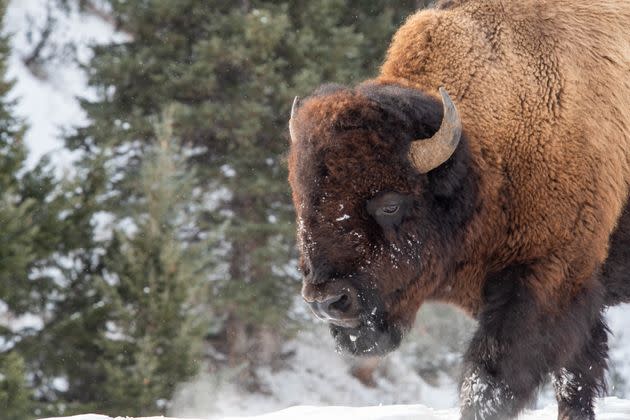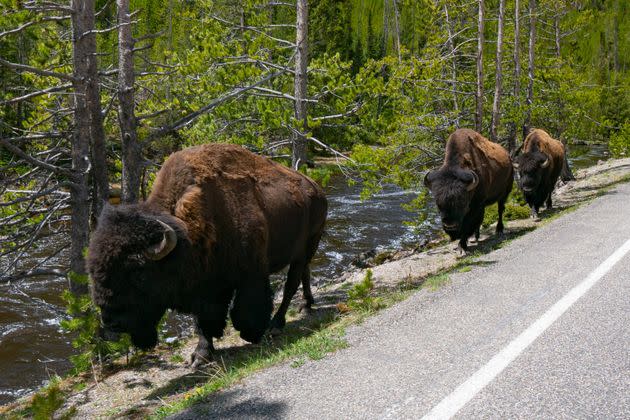Yellowstone Bison Face Endangered Species Act Review
The U.S. Fish and Wildlife Service will spend the next year assessing whether to protect Yellowstone bison under the Endangered Species Act — a court-mandated move that could affect recent attempts to reestablish wild herds on tribal reservations across the West.
The decision, published in the federal register by the Fish and Wildlife Service on Monday, stems from a series of lawsuits brought by the Buffalo Field Campaign and the Western Watersheds Project since 2014. Both groups want to see bison numbers in the park rise and hope to halt systematic culling outside Yellowstone National Park, which in some years has claimed more than 1,000 bison.

Bison roam in Yellowstone National Park in Wyoming on Feb. 1. Yellowstone Park is developing a new bison population management plan that could result in a decrease in the number slaughtered each year and transfer more to Native American tribes. (Photo: William Campbell via Getty Images)
“Bison are forced into boundaries,” said James Holt, the executive director of the Buffalo Field Campaign. “They’re slaughtered. They’re quarantined. The North American model of wildlife conservation is failing bison and we can do better.”
The decision came as a surprise to many observers of Yellowstone bison, given how well the animals are doing by historical standards.
“Market hunters” killed the animals en masse toward the end of the 19th century to sell their hides and tongues, nearly driving the animals to extinction. Only about two dozen bison lived in Yellowstone by 1902, according to the National Park Service.
Conservation efforts since then, however, have helped Yellowstone’s bison rebound to around 5,500 today.
“The Endangered Species Act is really designed to keep animals from becoming extinct,” said Jay Bodner, executive vice president of the Montana Stock Growers Association. “With a population of 5,500 on a growth trend, they certainly are not in that class.”
The Fish and Wildlife Service has generally agreed, declining to recommend bison for Endangered Species Act protections twice in response to the lawsuits.
But U.S. District Judge Randolph Moss found in January that the federal agency failed to consider recent genetic studies indicating that Yellowstone bison have evolved into two distinct herds, which in turn might warrant separate, higher population targets to protect genetic diversity.
The Fish and Wildlife Service’s third assessment, conducted in response to Moss’s ruling, called for a year-long review of the petition to protect Yellowstone’s bison based on their genetic diversity.
Endangered Species Act protections could have far-reaching and politically explosive impacts, if the Fish and Wildlife Service were to adopt them.
Wild bison migrate long distances. Yellowstone bison typically push north along the river bottom when snow begins to fall, following forage to lower-elevation winter range, moving through private land in the process.
But around 60% of wild bison carry brucellosis ― a bacterial disease brought to North America by beef cattle. Brucellosis exposure can devastate ranches, creating pressure to keep the animals away from domestic cattle as they migrate.
“If Yellowstone bison could roam freely with the infection rate they have, our livestock trading partners would put severe restrictions on Montana,” Bodner said.
To keep that from happening, federal and state agencies try to push bison toward public land as much as they can and haze them back into the park when they return to their summer range.
Authorities also kill hundreds of Yellowstone bison each year and distribute the meat and hides to tribes, largely to ease tensions over brucellosis with ranchers and conflicts with other private property owners outside the park.
It’s an awkward arrangement few are happy with. Montana conducts a highly coveted draw to hunt wild bison exiting the park, in which thousands apply for the chance at a few dozen licenses. Several tribes, exercising treaty rights, also hunt bison just outside the park under their own regulations.
Historically, government authorities killed far more bison than hunters. Authorities culled about 1,115 Yellowstone bison in the winter of 2017-18, according to court filings.

Bison walking along a highway in Yellowstone National Park. (Photo: Aaron P/Bauer-Griffin via Getty Images)
But over the last three years, the National Park Service has quarantined a small number of bison at the park to certify them as free from brucellosis, a process that requires multiple tests over more than a year.
Under the Bison Conservation Transfer Program, the National Park Service has worked with tribes across the country to ship live bison to help establish new herds or bolster existing ones. The National Park Service plans to double the capacity of the program in coming years, partly as an alternative to sending bison to slaughter. Last year, the number of culled bison had dropped to 187.
Extending Endangered Species Act protections raise questions about the program and may threaten tribal nations’ treaty rights, according to Eastern Shoshone Tribal Buffalo Representative James Baldes.
Baldes spent the last 15 years restoring the Eastern Shoshone Tribe’s bison herd. He called the transfer program a “success story that has restored many Yellowstone buffalo to tribes across the nation, and even to Alaska,” including his.
Supporters of extending protections to Yellowstone bison say the law allows for exceptions to capture and transfer live animals to develop new populations.
“Even if bison were listed in Yellowstone, the gathering of bison for reintroduction efforts would be allowed to continue,” said Erik Molvar, executive director of the Western Watersheds Project. “It’s pretty common for a very rare species to require trapping and relocation to establish new populations.”
But the Secretary of the Interior must approve those exceptions, and populations receiving transfers are also protected, which could complicate the Eastern Shoshone Tribe’s goal of hunting its wild herd. Neither the Fish and Wildlife Service nor the National Park Service responded to requests for comment.
“I would hope the ESA does not impede the exercise of sovereignty around buffalo restoration, especially in terms of buffalo genetics,” Baldes said. “Those are the remnants of our once vast herds and the tribes should have first say in what happens to them.”
“To list bison as an endangered species or a threatened species would greatly diminish the efforts to restore bison to tribal lands lands for cultural and ecological restoration,” Baldes said. “We know the genetics of Yellowstone are very important. We want to make sure that we’re getting those animals alive to ensure herd health.”
Fights over whether to list a given animal under the Endangered Species Act are often more about politics than biology, according to South Dakota bison rancher Dan O’Brien, author of “Buffalo for the Broken Heart.”
Like many others, he viewed the pressure to list bison as a threatened species with suspicion. But the law was also designed to respond to petitions with scientific assessments. Only scientific research can tell whether Yellowstone bison have genetics demanding extra protection.
“I’ve worked with the Fish and Wildlife Service my entire life and they want to do the right thing,” O’Brien said. “I think we have to stand back and let the Act work.”
CLARIFICATION: A previous version of this piece did not include information about how the ESA’s exemptions may affect tribal nations’ bison restoration programs. Details about those exemptions have been added following additional interviews with Baldes and Erik Molvar.
This article originally appeared on HuffPost and has been updated.

